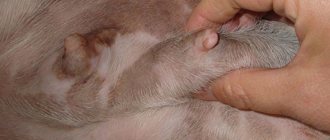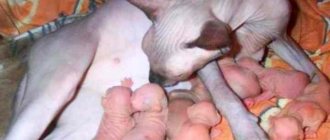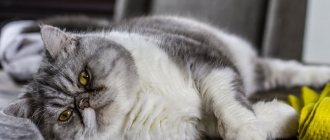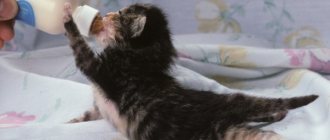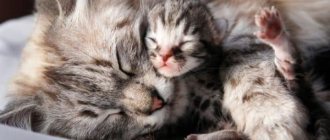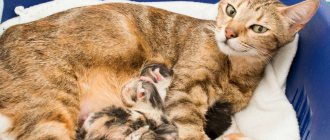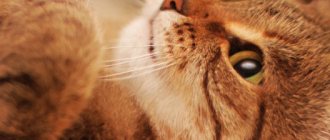One of the common diseases of furry beauties is a mammary gland tumor in a cat. Oncological pathology most often affects older animals.
At the same time, the percentage of cases decreases sharply when sterilization is carried out in the early stages. A malignant course of the disease is observed in 85% of 100 cases.
Modern veterinary medicine has a number of methods for treating mammary tumors, but the success of therapy depends on timely treatment.
A lump on the nipple is a serious threat to the life of a cat!
The appearance of even a small lump near the nipple in a cat is considered a serious symptom, since the risk of developing a tumor process in the mammary glands is very high. This is especially true for individuals over the age of 10 years. Malignant neoplasms are diagnosed in every second case. There are no safe reasons for the appearance of lumps on the nipples, since even the appearance of benign formations in this area signals that the animal has an unstable hormonal balance, which often leads to serious consequences.
Preventive measures
Owners of domestic cats should carefully monitor the condition of their pet's nipples, since tumors in them are most often malignant. If even small balls appear under the skin, it is necessary to urgently show the animal to a veterinarian. To protect your pet from this terrible diagnosis, you need to follow the recommendations of specialists:
- Sterilize a nulliparous female before puberty. Many scientific studies have shown that spayed females have a reduced risk of developing malignant tumors on the mammary glands.
- Do not use hormonal contraceptives. During the period of female heat, people usually use veterinary drugs that neutralize its symptoms. These medications contain hormonal substances that disrupt the activity of the animal’s own gonads.
- Use quality feed. Cheap food with a large number of additives and carcinogens is one of the reasons for the development of cancer in animals.
If the nipple is swollen due to mastitis or mastopathy, then the prognosis in this case will be favorable. However, mastitis also causes a lot of trouble for the animal, so it is better to try to prevent it. Prevention of this disease includes the following measures:
- regular antiparasitic treatment;
- eliminating the possibility of your pet getting injured and hypothermia;
- preventing stagnation of milk in the breast of a nursing female, applying kittens to all nipples;
- frequent change of bedding for a female with kittens;
- trimming babies' claws if they damage the skin on the mother's chest;
- the use of special ointments for cracks in the areolas and nipples.
List and description of possible causes
If a cat develops a ball on the nipple at a young age, there is a good chance that this symptom is not associated with malignant processes, but in the future it is necessary to keep in mind the following pathologies:
- Mastitis. An inflammatory disease of the mammary glands, which usually appears during the postpartum period and during pseudolactation. Due to excess milk, swelling may appear on the nipples. Without pumping, the process can be complicated by pain in the abdominal cavity. In advanced cases, abscesses and deep ulcers may appear. Treatment is individual depending on the clinic. The drugs Mastomethrin and Monclavit may be prescribed. In the presence of abscesses, surgical intervention, antiseptic treatment of wounds and drainage are indicated.
- Neoplasms. The worst problem for most cats, since the mortality rate when mammary tumors are detected is quite high. Most oncologists assure that any tumor on the nipple can be considered conditionally benign, since surgical intervention with subsequent removal of the lump is still required. Malignant neoplasms occur in animals after 10 years of age. The process can last for several years without showing itself in any way. But, at one point, the pet develops single or multiple formations near the nipples, which “before our eyes” increase in size. The best decision is to immediately contact an oncologist for an abdominal ultrasound, radiography and visual examination (palpation of all nipples). There is always a lot of controversy about removal, since cancers almost always affect older individuals who have little chance of surviving anesthesia. But, refusal to remove the tumor will undoubtedly lead to the pet experiencing excruciating pain when it begins to ulcerate (this always happens in the last stages), bleed and fester. Benign tumors are successfully excised (almost always not the nipple itself, but the entire mammary gland) and the risk of developing malignant tumors in the mammary gland area is reduced to a minimum.
- Abscess. Another inflammatory process that can occur in the mammary glands. Most often, the appearance of ulcers provokes stagnation of milk after childbirth or during pseudolactation. The cat develops soft nodules near the nipple, reaching the size of a small pea. The inside of abscesses is filled with pus, which is removed surgically after opening the abscess. Antiseptic treatment of wounds and wearing a protective blanket are indicated to prevent secondary infection. Antibiotic therapy is also indicated, which is selected by a veterinarian based on the clinical picture.
- Blocked milk ducts. It can also lead to the appearance of lumps on the nipples. At the same time, there is an increase in size and redness. When touched, the cat experiences pain. Treatment includes special compresses applied to the abdominal cavity to relieve swelling, diuretics, and exclusion of food for at least 12 hours. Occurs immediately before childbirth and in the first 5-10 days after it.
- Lack of or difficult milk output can also cause a lump to appear near the nipple. At the same time, the cat behaves restlessly and does not allow the cubs to approach it. This can be explained by a defect in the development of the mammary gland, which cannot be treated.
Mastopathy
Mastopathy is the degeneration of breast tissue. For cats, this is almost always a precancerous condition, so under no circumstances should you hesitate to consult a doctor. There is only one symptom of mastopathy - enlargement of the mammary gland, not associated with pregnancy. The seal can be of different sizes, not welded to the skin, with smooth edges. For cats, mastopathy does not cause inconvenience, so the onset of the disease is easy to miss.
The disease is diagnosed after puncture of the mammary gland with biopsy. During this procedure, the mammary gland is pierced with a needle and the contents of the tumor are aspirated with a syringe. Even if there is no liquid discharge, the tissue remaining in the needle is sent for cytological examination.
Depending on the condition of the animal, the doctor may prescribe conservative therapy or surgical treatment. Conservative therapy is carried out if the risk of malignancy of the process is low (usually hormonal correction and vitamin therapy). Surgical treatment is indicated when there is suspicion of malignant degeneration of the tumor. During the operation, both the nipple and the mammary gland are removed, and their tissues are sent for histological examination.
Mastopathy is an inflammation of the mammary gland, accompanied by the appearance of cysts and other lumps. A disease without treatment and constant veterinary control can become an impetus for the formation and proliferation of cancer cells.
Mastopathy is more common in individuals who have given birth and is practically not diagnosed in cats that were sterilized at an early age (before a year or a little over a year).
The signs of the pathology are in many ways similar to the symptoms of mastitis:
- the cat's chest is swollen;
- bleeding appeared;
- the glands are visually enlarged;
- touching causes pain to the female.
Timely identified mastopathy responds well to treatment - cats tolerate medications and injections well. The disease at the initial stage is treated with drugs containing iodine and immunomodulators.
In advanced cases, when ulcers appear on the skin, conservative therapy is ineffective. Serious lesions require surgery, during which the affected glands, as well as the uterus and ovaries, are partially or completely removed. The animal will require long-term rehabilitation.
Lump near a cat's nipple photo
To timely detect any formations in your cat, you need to palpate the mammary gland area at least once a month. Particular attention is paid to the first 10-15 days after estrus, since according to statistics, it is during this period that most neoplasms are detected.
Why is my cat's nipple swollen?
Any hormonal changes in a cat’s body are not without consequences. For example, the behavior of a pet changes. From a calm “pillow” on the sofa, she turns into a restless, unhappy creature who is worried about something. Or, a swelling or small lump may appear on the nipple, which will disappear in a day or two. But most often, with hormonal fluctuations in a cat’s body, all nipples swell.
It is also important that the cat can also have problems with hormones. Therefore, such a phenomenon as: a swollen nipple can be equally expressed in both male and female cats.
What if the owner notices abnormal phenomena. Such as only one nipple is swollen. What could it be? So what should I do? Wait until other signs of a surge in hormones appear? Change food? Check stool? Look in reference books for clues to similar symptoms? Or should I rush to the doctor with my cat?
So, only the cat's nipple itself is swollen. And besides its swelling, you can notice other symptoms :
- Redness;
- The cat is lethargic and refuses even its favorite food;
- Perhaps sores have appeared around the nipple;
- When we touch the mammary gland, the cat begins to hiss or quickly runs away (this indicates that it is in pain).
What could it be? There are several explanations for this phenomenon, and it is too early to draw conclusions until the doctor has examined the tumor on the cat's nipple.
And yet, what symptoms of diseases is that the cat’s nipple is swollen?:
- Cancer;
- Mastitis, as a blockage of blood vessels in a cat's nipple;
- Benign tumor.
Mastitis
Mastitis usually develops in a nursing cat, although it can occur in a pregnant cat. It is due to the fact that milk stagnates in the mammary glands. And this stagnation is accompanied by infection. In this case, the mammary gland looks swollen, painful, it is fused to the skin, and the vascular pattern is clearly visible.
The nipple is dense, hot, covered with small cracks. The cat avoids touching the belly, but she licks the sore nipple more often than others. When you press on the nipple, you can see a cheesy discharge. Because treatment, which includes vitamins, antibiotics, immunostimulants.
What to do
Cancer on the nipple
First of all, it is worth noting that although cancer can occur at any age, it most often affects older cats, at 8-10 years of age.
Animal behavior. The cat feels great at the very beginning. The cancer begins and grows, but no signs are noticeable. The nipples, like the entire body of the animal, look the same as those of a healthy cat. Changes can only be detected starting from the second stage. If you then intervene in the course of the disease, you can expect to save the cat.
But when one or more nipples are swollen, when her appetite and lifestyle changes, she turns from active to withdrawn, and is rapidly losing weight, then it’s worth paying attention to. And first you need to examine the cat. Feel her nipples and lymph nodes.
Stages of the disease. Cat cancer also has 4 stages of development, just like in humans. At the first stage, there are no special visible signs of the disease. This can only be discovered by chance during a detailed check with analysis.
On the second, the nipple swells. At first, soft tumors are felt in it, then they become denser. On the third, everything becomes more obvious, various signs confirm this: the nipple becomes more deformed due to the growing tumor underneath it, and the lymph nodes become inflamed. The cat is losing weight and becoming aggressive. At the fourth stage, doctors do not give any hope. Even surgery will most likely not help a cat exhausted from the disease.
Mastitis
Due to physiological characteristics, or due to injuries, both in dogs and cats that are nursing or have just fed their babies, the nipple may become enlarged and thickened due to blockage of blood vessels in the animal’s chest.
Animal behavior. The cat becomes lethargic, its mammary gland is enlarged, its nipple hurts and its temperature may rise.
Benign tumor
Mammary tumors in cats can also be non-aggressive. And most often it is the owners, or rather, their “care” that can become the reason for this. For example, if you give hormones instead of castrating a cat.
What to do
The first thing to do is to carefully examine the nipple yourself. To understand the nature of the disease, whether there is a tumor under the nipple and to see the cat’s reaction.
The next step is to take your pet to a doctor for examination . Only a specialist can accurately determine the cause of the tumor and decide what needs to be done. It may be necessary to remove breast tumors surgically if the cancer is in its early stages. Or, if it is mastitis, and the tumor is the remains of milk. You will need to take a course of antibiotics. In any case, both diagnosis and treatment are prescribed only by a veterinarian
Obsessive-compulsive disorder
Stress can lead to compulsive behavior, including excessive licking. With its help, the cat stimulates the release of calming chemical compounds in the brain. When an animal becomes dependent on behavior, it can injure itself.
Thus, constant intensive washing in the abdominal area will cause the lower nipples of cats to enlarge and turn red. At the same time, hair falls out in the affected area.
OCD does not affect the size of the mammary glands. The diagnosis is made after a comprehensive examination, during which the veterinarian checks the animal for the presence of:
neoplasms and other potential causes of changes.
Having determined that the condition is caused by a nervous reaction, the doctor will advise providing the pet with the most stable lifestyle possible. If stress is triggered by the appearance of a new animal, the owner should pay more attention to the cat, especially during attacks.
Injuries
A cat may hit or injure its stomach when jumping, playing or fighting with another pet. If the impact was on the nipple or surrounding area, there is a possibility of redness and swelling. Blood and ichor may be released.
If the condition does not bother your pet, you should wait a couple of days - during this time the injuries often heal on their own. If changes persist for more than a week or the cat shows signs of discomfort (meowing, restless behavior, increased attention to the affected area), it is necessary to show it to the veterinarian.
Infections
Pathogens enter the mammary glands through wounds, through the circulatory and lymphatic systems. If in a normal state the owner may doubt whether cats have nipples, then during infection they clearly appear on the stomach. The disease is accompanied by:
release of liquid or thick mass;
swelling of the gland and adjacent tissues.
The affected area feels hotter to the touch compared to the rest of the body. The veterinarian prescribes a course of antibiotics or antiviral drugs, depending on the pathogen, age, weight and general condition of the pet. The owner, for his part, must provide the cat with peace.
If the disease is contagious, it is isolated from other animals - separate dishes and a tray are allocated, and common objects are disinfected.
Hormonal imbalance
Enlargement of the mammary glands and nipples in males occurs when treated with progesterone. The hormonal drug is used, in particular, for behavior correction. The appearance of your pet's belly may change soon after treatment begins.
Normally, after taking the product, the nipples return to their original state. But sometimes taking hormones leads to hypertrophy of the glands.
The problem may occur 2-6 weeks after administration of the drug. The condition is often accompanied by swelling of the hind legs. Your veterinarian may recommend removal of the affected glands. Surgery is also used for glandular hyperplasia.
In males, this condition is one of the potential side effects of progesterone treatment. Surgery is resorted to when ulcers form on the affected area.
In the absence of such radical symptoms, stop giving hormones and monitor the pet. Additionally, the doctor may prescribe anti-inflammatory drugs.
Hormonal surges are a potential result of disruption of internal organs. In females, breast enlargement is observed during estrus. The period of attraction in males has less influence on the appearance of the nipples.
But the mammary glands of males can also react to dissatisfaction of sexual needs. Veterinarians recommend sterilizing (castrating) animals if the owner does not plan to breed.
Neoplasms
Adenocarcinoma is a malignant tumor that affects the glands. It often affects adult, unsterilized females, but can also occur in males. The tumor can be felt as a dense, nodular formation around one or more mammary glands. The development of oncology is accompanied by:
redness and discharge from the nipple.
Cancer is diagnosed by examination, blood tests and biopsy. The animal is prescribed chemotherapy and, in most cases, removal of the mammary glands and associated lymph nodes.
In the early stages, the veterinarian may limit himself to intervention in the area of the neoplasm. But usually one or both rows of glands are removed. This happens because tumors can appear on different sides of the abdomen.
There is also a risk of cancer cells spreading through the blood and lymphatic vessels.
The operation is performed under general anesthesia. The duration depends on the size of the tumors and how many nipples the cat has. Most individuals have 8 of them, but there are other options - 6 or 4 pieces.
The animal may develop skin cancer of the nipples. The tissue degenerates, which is characterized by redness or crusting. Discharge may also be observed: clear, whitish or bloody. Treatment is based on chemotherapy and, if necessary, removal of the affected areas.
Treatment
Once a pet has been given a disappointing diagnosis of a tumor, removing the cat’s mammary tumor is often the only way to save his life. If the pathology is benign, then after removal surgery there will be an almost complete recovery. But it is important to do this before inflammation or ulceration begins.
In cases where surgical treatment is not possible for certain reasons, conservative methods are used. Thus, for benign pathologies, the essence of such therapy will be to stop the growth and development of the pathology, as well as to prevent infection of the abnormal tissues. In addition, it is necessary to increase the animal’s immunity level.
For this purpose, various antitumor and antibacterial agents are used. This could be Dokosorubicin. Also, if there is cancer in a pet, Cyclophosphamide is used, which has a cytostatic effect. Non-steroidal anti-inflammatory drugs are also prescribed, which include Meroxicam, and painkillers and antibiotics are used.
When adenocarcinomas are detected, they are surgically removed. In this case, resection of pathological tissues is carried out, along with all tissues of the organ, to prevent metastasis. The procedure consists of several stages, due to the fact that a complete mastectomy when performed in one stage is extremely difficult for animals to tolerate.
The course of treatment for the cat is prescribed depending on the results of the tumor examination. The benign lump is excised, after which the animal makes a full recovery. The cancerous lesion will also have to be removed to save the pet’s life. However, in this case, additional therapy is usually required after surgery to reduce the likelihood of relapse.
Mastitis in a cat can be cured with ointments, injections and tablets. As a rule, veterinarians prescribe Gamavit or Catozal, a solution of calcium gluconate. Injections of Travmatin and Mastometrin are used both for the treatment and prevention of mastitis. The duration of the course and dosage are determined by the doctor, taking into account the pet’s weight and other conditions.
In severe cases of purulent mastitis, antibiotics are prescribed. If there is a significant increase in body temperature, the animal is given an injection of analgin with diphenhydramine. When pus flows from the nipples or they bleed, it is necessary to treat with Chlorhexidine or hydrogen peroxide. If your nipples are inflamed, it is recommended to smear them with products that have a wound-healing and analgesic effect. The condition of swollen glands can be normalized with the help of ointments (Mastiet Forte, Gamabiol, Iruksovetin, Levomekol, Trauma-gel).
Surgery is the main way to combat malignant tumors. The veterinarian prescribes surgery after assessing the size of the lesion and the condition of the cat. Depending on the degree of growth of pathological tissue, one or more mammary glands are removed. In case of bilateral pathology, 2 operations are performed with an interval of 14 days. However, when cancer cells penetrate the skin, the affected area on the abdomen is completely removed in one operation.
Doctors usually recommend removing lymph nodes to reduce the risk of cancer cells growing back. In some cases, it is also necessary to remove the ovaries and uterus.
Chemotherapy is used in the treatment of cancer in animals. It is usually carried out to prevent relapses. Cats are given such strong drugs as Doxorubicin and Cyclophosphamide. These drugs can completely stop the development of tumor processes. However, these medications have many side effects and lead to severe intoxication. Pets can only be treated with these drugs under the close supervision of a specialist.
In some cases, it is impossible to operate on a cat due to its age or concomitant chronic diseases. In this case, chemotherapy becomes the only way to stop the growth of the tumor and prolong the life of the pet.
Sometimes surgery is refused because the size of the lump is too small. In such situations, chemotherapy can give excellent results and lead to a complete recovery of the cat.
Folk remedies
Folk remedies are used, as a rule, in the treatment of mild forms of mastitis. Warm compresses with herbal infusions have a positive effect. For lotions, decoctions of oak bark, sage and chamomile are prepared. It is very important that the infusion is not hot. Excessive heating of the affected area can make the situation worse.
Damaged nipples can be gently massaged with camphor or ichthyol oil. After this, a bandage should be applied to the lubricated areas for a short time to prevent the animal from licking the oil.
With malignant tumors, the cat may experience severe pain. In this case, the use of folk remedies as additional therapy is allowed. Decoctions of herbs such as calendula, spurge, arnica, wild rosemary and knotweed will help slow down abnormal cell growth and reduce pain.
For benign formations, decoctions of burdock, cinquefoil, plantain, tartar, fireweed will contribute to a stable improvement in the pet’s condition. For cancerous tumors, these herbs will help contain the development of metastases.
Causes and diseases causing compactions
The appearance of such a nuisance as a tumor should not be neglected. The diseases that these seals can indicate are serious, sometimes even fatal. If a cat has swelling around her nipples, it means she is either pregnant (pregnant) or sick. There are ailments that provoke the appearance of swelling and compaction:
- Mastitis is a disease of representatives of the cat family, which is accompanied by neoplasms in the nipple area. Inexperienced owners may be scared when they feel a lump on their cat's stomach. Most often it occurs due to infectious infection or the active development of the inflammatory process. It appears in nursing cats.
- Feline hyperplasia is a disease of intact (not sterilized) animals, which is characterized by the presence of benign tumors.
- Breast cancer most often affects females, but sometimes occurs in cats. A specific sign of such a serious illness is a malignant, rapidly growing lump.
- Stagnation of milk in the glands occurs due to early separation of kittens from the cat or an abnormally large amount of milk.
Such diseases can be either an independent failure in the pet’s development or a consequence of improper care or conditions. The root causes are sometimes pathological heredity, poor environmental conditions, unbalanced or poor-quality nutrition, lack of walks, weakened immunity, stress, and acute illnesses.
Therapy
Treatment for hard mammary glands in a nursing cat depends only on what causes these lumps. For diseases such as mastopathy and cancer, a qualified veterinarian prescribes conservative therapy or surgical treatment. In the first case, the animal takes medications aimed at stabilizing hormonal levels and vitamins. In the second case, surgical intervention is performed, during which the mammary gland and nipple are removed. Subsequently, they are sent for laboratory testing.
In some cases, there are indications that do not allow surgery. The reason for refusal may be a weak heart. Then there is another way - chemotherapy. This method is also quite serious; it is prescribed when the purr has a strong liver and kidneys. Chemotherapy for cats is carried out using the following drugs:
All final decisions are made after a detailed study of all influencing factors. The opinion of experts depends on:
- stage and type of cancer;
- tumor localization;
- general health of the animal;
- material capabilities of the owners.
Radiation therapy has become an analogue of radiation therapy. This procedure is used not only to eliminate cancer cells, but also to neutralize their consequences. Ionized radiation, entering the body, prevents cancer relapses. Based on the type of beam, this therapy is divided into x-ray therapy and gamma therapy.
Parallel symptoms
Usually, the owners of the animal notice the formations when the process has gone far and several stages (stages) of the disease are already behind. Therefore, it is extremely important to conduct an annual scheduled examination of your furry friend, or at least monitor his condition yourself. Early detection of the problem greatly increases the chances of recovery.
Owners of a sick pet need to give it maximum attention. When a cat's mammary glands swell after kittens, she experiences pain, ulcers appear and her body temperature rises. The early stages are characterized by changes in behavior, lack of appetite, and fever. Breastfeeding cats may suddenly become averse to their kittens and stop caring for them. If you independently examine the animal, you may find that the mammary glands are hot and swollen. At the first stage, tumors are soft and not so easy to feel, so an indicator such as nipple temperature can help detect deviations.
The second stage has more pronounced symptoms. The compaction increases slightly and becomes denser. In the final stages, metastases appear in the lymph nodes, and secondary lesions form in the liver and other organs. It is difficult for animals to bear this pain, so they aggressively and persistently reject attempts to touch the sore spot.
Prevention
It is important to know not only how to treat mastitis in a cat, but also how to prevent it. Below we have prepared a list of useful tips for you in this case:
| Monitoring your cat's fluid intake | If there are few kittens, then limit the amount of liquid you drink for the cat who has given birth. |
| "Manicure" for kittens. | Also, be sure to trim your kids' nails. They can scratch their mother's nipples while sucking. This will cause bacteria to enter the cat's mammary glands. |
| Diet of a pregnant and lactating cat | Be sure to discuss the diet of your pregnant and lactating cat with an experienced veterinarian. Some types of food (cottage cheese, mineral or vitamin supplements, etc.) stimulate milk production. |
| Maintain animal hygiene | Dirty bedding, floors, and tray can lead to bacterial contamination of the nipples. If necessary, wash the skin with a decoction of oak bark, a very weak solution of potassium permanganate (literally a crystal in half a liter of water). If you notice cracks, be sure to lubricate them with cream. |
| Avoid injury | Place the pet's bed away from drafts. |
| Deworming, preventative treatment against fleas and ticks | Carry out deworming in a timely manner (parasites greatly weaken the immune system). Don't forget about ticks and fleas. They not only reduce the body's defenses, but also cause itching. As a result, the cat scratches itself, thereby opening the “gate” for pathogenic bacteria. |

